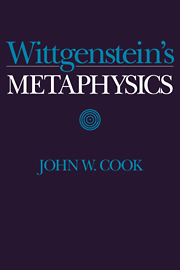Book contents
- Frontmatter
- Contents
- Preface
- List of Abbreviations
- Introduction
- Part I From Idealism to Pure Realism
- Part II The Metaphysics of Wittgenstein's Later Philosophy
- 7 Wittgenstein's Phenomenalism
- 8 A New Philosophical Method
- 9 Wittgenstein's Behaviorism
- 10 Wittgenstein and Kohler
- Part III Causation and Science in a Phenomenal World
- Part IV Logical Possibilities and the Possibility of Knowledge
- Part V The Past, Memory, and The Private Language Argument
- Name Index
- Subject Index
7 - Wittgenstein's Phenomenalism
Published online by Cambridge University Press: 05 November 2011
- Frontmatter
- Contents
- Preface
- List of Abbreviations
- Introduction
- Part I From Idealism to Pure Realism
- Part II The Metaphysics of Wittgenstein's Later Philosophy
- 7 Wittgenstein's Phenomenalism
- 8 A New Philosophical Method
- 9 Wittgenstein's Behaviorism
- 10 Wittgenstein and Kohler
- Part III Causation and Science in a Phenomenal World
- Part IV Logical Possibilities and the Possibility of Knowledge
- Part V The Past, Memory, and The Private Language Argument
- Name Index
- Subject Index
Summary
Wittgenstein's ideas about the relation of sense-data and material objects are not easily discovered and are even less easily explained. There are several reasons for this, the most important of which is that his ideas underwent a change between the time of the Tractatus and his later work. This change in his thinking has been widely misunderstood. The received view is that Wittgenstein at some point ceased to hold a phenomenalist view of material things. In this chapter we will see that this interpretation is wrong. The change that took place in his thinking had nothing to do with allowing the existence of objects he had formerly dismissed in a reductionist fashion. His change of mind consisted merely in the adoption of a new form of phenomenalism. To understand this, we must begin with the Tractatus view of the matter.
The Tractatus Version of Phenomenalism
Nowhere in the Tractatus does Wittgenstein explicitly discuss the relation of sense-data and material things. It is nevertheless possible to determine what his view was at that time. As we have seen, he held that phenomenal entities comprise “the substance of the world,” while also holding that ordinary language is “in perfect logical order” (TLP, 5.5563). From this we may infer that he thought of material things as being, in some sense, reducible to sense-data – to colors, shapes, etc.
- Type
- Chapter
- Information
- Wittgenstein's Metaphysics , pp. 85 - 100Publisher: Cambridge University PressPrint publication year: 1994



